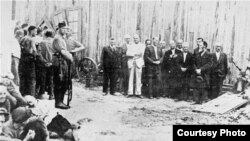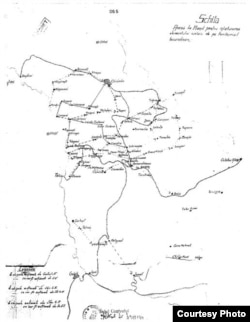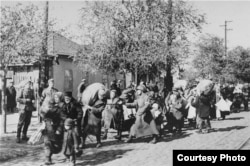In July 1941, Ura and Motl Gabis, two brothers living in the town of Edinet, in what is today Moldova, were taken with their mother and father from their home at gunpoint. They were lined up along the wall of a barn and shot. Their crime was their Judaism.
The shooter, Stepan Derevenchuk-Babutsak, was an unemployed son of peasants who knew which homes were Jewish. His gun came from local authorities who sent civilians to get an early start on the systematic cleansing to come when pro-Nazi Romanian and German soldiers swept in.
Evidence that these local attacks were ordered by the Romanian military under then-Prime Minister Ion Antonescu -- and were not spontaneous, as was long claimed -- can be found among the more than 40 million pages of archives held at the U.S. Holocaust Memorial Museum in Washington.
The plan, complete with a map of target villages (see below), turned neighbors into murderers on ground fertile for anti-Semitism.
But now, a tranche of documents newly delivered to the Holocaust Museum by the Moldovan government is providing researchers with fresh evidence of the plan's execution -- and a look into the lives of victims and perpetrators alike.
"A plan is evidence of a crime, but when you don't have the result of this plan, then it's only half of the story," says Vadim Altskan, coordinator of the museum's International Archival Program. "So what we now have is the implementation, or results -- who did this and how it actually worked. We have details -- how it worked at the village-level."
The case of Derevenchuk-Babutsak and his killing of the Gabis family is one of about 50 investigations and trials that are contained in the archive. They were carried out by the Moldovan KGB starting in 1944, after the Soviets liberated the area, and continued into the late 1950s.
In total, there are some 15,000 pages of testimony, interrogation transcripts, and other documents -- all contained on a computer hard drive that was handed over by Moldovan Deputy Prime Minister Iurie Leanca at a ceremony in March.
Bessarabian Killing Fields
Reading this particular case, Altskan quotes the shooter, Derevenchuk-Babutsak, during an interrogation in 1944, where he denies committing any crimes.
Then comes a twist.
While their parents fell dead beside them, the brothers, Ura and Motl Gabis, survived. They would live to testify against their shooter, who would be sentenced to 20 years of hard labor.
This and other cases provide not only evidence of barbarism, but also tell stories of co-opted ignorance, survival, and even love.
According to Radu Ioanid, the Bucharest-born archival director at the Holocaust Museum, the Gabises were among some 300,000 Jews living in Bessarabia, the territory that largely constitutes today's Moldova, and the neighboring region of Bukovina in 1930.
Tens of thousands were killed during the Romanian/Nazi assault, while others were sent to regional internment camps and ghettos. From there, Ioanid says, most were carted off to the killing fields of Transdniester, today a breakaway region of Moldova.
"One hundred and fifty thousand Jews from Bessarabia and Bukovina reached Transnistria alive [in 1941-42]," he says. "Two years later, only 50,000 were alive. That's the story. Transnistria was the ethnic dumping ground of the Romanian pro-Nazi government."
The Moldovan government estimates that there are some 15,000 Jews living in the country today.
National Politics In Play
Ioanid spearheaded the museum's efforts to obtain the archive. To succeed, the museum had to overcome political hurdles by enlisting U.S. Vice President Joseph Biden to push for an amendment to Moldovan restrictions on the international transport of personal data.
In fact, national politics often come into play when the museum tries to expand its repository.
Altskan says that among the countries of the former Soviet Union, the museum has yet to obtain postwar trial records held in Belarus, Kyrgyzstan, Tajikistan, and Turkmenistan.
"The most important out of the four is Belarus. First of all, it was under Nazi occupation [and] you had a large Jewish community. We visited them. They were ready to work with us -- actually, more than willing," he explains. "It's because of our own government and sanctions we have against Belarus [that] we were told very clearly that it's not a good idea to collaborate with the local KGB."
U.S. law prohibits the transfer of equipment that the Holocaust Museum would ship to Minsk to assist in the copying of documents.
For the countries that hold Holocaust-era documents, there may also be a political advantage, perceived or real, to working with the U.S. museum, which is partially government-funded.
At the handover ceremony for the archives, Chisinau's Leanca expressed hope that the move would help convince U.S. lawmakers to repeal trade restrictions against Moldova stemming from Soviet-era limitations on Jewish emigration.
Educating Communities
But foremost, Leanca said, was his country's commitment to "paying respect to the tragedy that occurred on our soil to make sure we draw the necessary lessons looking forward."
Indeed, leaders of Moldova's Jewish community are hoping that the new insight into Holocaust-era crimes will have reverberations at home.
"Unfortunately, the extent that today's students and youth are informed about the tragedies of the Holocaust is not sufficient," says Aleksandr Bilinkis, the vice president of the Organization of the Jewish Communities in Moldova.
"Moreover, the topic is not talked about or is distorted. Historical facts are twisted. In some places even the opposite happens, when information about the tragedies of these years are checked and [then] distorted to satisfy the prevailing political needs."
The U.S. Holocaust Memorial Museum has expressed its interest to Chisinau in a continued partnership, including in the sphere of Holocaust education.
The shooter, Stepan Derevenchuk-Babutsak, was an unemployed son of peasants who knew which homes were Jewish. His gun came from local authorities who sent civilians to get an early start on the systematic cleansing to come when pro-Nazi Romanian and German soldiers swept in.
Evidence that these local attacks were ordered by the Romanian military under then-Prime Minister Ion Antonescu -- and were not spontaneous, as was long claimed -- can be found among the more than 40 million pages of archives held at the U.S. Holocaust Memorial Museum in Washington.
The plan, complete with a map of target villages (see below), turned neighbors into murderers on ground fertile for anti-Semitism.
But now, a tranche of documents newly delivered to the Holocaust Museum by the Moldovan government is providing researchers with fresh evidence of the plan's execution -- and a look into the lives of victims and perpetrators alike.
"A plan is evidence of a crime, but when you don't have the result of this plan, then it's only half of the story," says Vadim Altskan, coordinator of the museum's International Archival Program. "So what we now have is the implementation, or results -- who did this and how it actually worked. We have details -- how it worked at the village-level."
The case of Derevenchuk-Babutsak and his killing of the Gabis family is one of about 50 investigations and trials that are contained in the archive. They were carried out by the Moldovan KGB starting in 1944, after the Soviets liberated the area, and continued into the late 1950s.
In total, there are some 15,000 pages of testimony, interrogation transcripts, and other documents -- all contained on a computer hard drive that was handed over by Moldovan Deputy Prime Minister Iurie Leanca at a ceremony in March.
Bessarabian Killing Fields
Reading this particular case, Altskan quotes the shooter, Derevenchuk-Babutsak, during an interrogation in 1944, where he denies committing any crimes.
Then comes a twist.
While their parents fell dead beside them, the brothers, Ura and Motl Gabis, survived. They would live to testify against their shooter, who would be sentenced to 20 years of hard labor.
This and other cases provide not only evidence of barbarism, but also tell stories of co-opted ignorance, survival, and even love.
According to Radu Ioanid, the Bucharest-born archival director at the Holocaust Museum, the Gabises were among some 300,000 Jews living in Bessarabia, the territory that largely constitutes today's Moldova, and the neighboring region of Bukovina in 1930.
Tens of thousands were killed during the Romanian/Nazi assault, while others were sent to regional internment camps and ghettos. From there, Ioanid says, most were carted off to the killing fields of Transdniester, today a breakaway region of Moldova.
"One hundred and fifty thousand Jews from Bessarabia and Bukovina reached Transnistria alive [in 1941-42]," he says. "Two years later, only 50,000 were alive. That's the story. Transnistria was the ethnic dumping ground of the Romanian pro-Nazi government."
The Moldovan government estimates that there are some 15,000 Jews living in the country today.
National Politics In Play
Ioanid spearheaded the museum's efforts to obtain the archive. To succeed, the museum had to overcome political hurdles by enlisting U.S. Vice President Joseph Biden to push for an amendment to Moldovan restrictions on the international transport of personal data.
In fact, national politics often come into play when the museum tries to expand its repository.
Altskan says that among the countries of the former Soviet Union, the museum has yet to obtain postwar trial records held in Belarus, Kyrgyzstan, Tajikistan, and Turkmenistan.
"The most important out of the four is Belarus. First of all, it was under Nazi occupation [and] you had a large Jewish community. We visited them. They were ready to work with us -- actually, more than willing," he explains. "It's because of our own government and sanctions we have against Belarus [that] we were told very clearly that it's not a good idea to collaborate with the local KGB."
U.S. law prohibits the transfer of equipment that the Holocaust Museum would ship to Minsk to assist in the copying of documents.
For the countries that hold Holocaust-era documents, there may also be a political advantage, perceived or real, to working with the U.S. museum, which is partially government-funded.
At the handover ceremony for the archives, Chisinau's Leanca expressed hope that the move would help convince U.S. lawmakers to repeal trade restrictions against Moldova stemming from Soviet-era limitations on Jewish emigration.
Educating Communities
But foremost, Leanca said, was his country's commitment to "paying respect to the tragedy that occurred on our soil to make sure we draw the necessary lessons looking forward."
Indeed, leaders of Moldova's Jewish community are hoping that the new insight into Holocaust-era crimes will have reverberations at home.
"Unfortunately, the extent that today's students and youth are informed about the tragedies of the Holocaust is not sufficient," says Aleksandr Bilinkis, the vice president of the Organization of the Jewish Communities in Moldova.
"Moreover, the topic is not talked about or is distorted. Historical facts are twisted. In some places even the opposite happens, when information about the tragedies of these years are checked and [then] distorted to satisfy the prevailing political needs."
The U.S. Holocaust Memorial Museum has expressed its interest to Chisinau in a continued partnership, including in the sphere of Holocaust education.

















